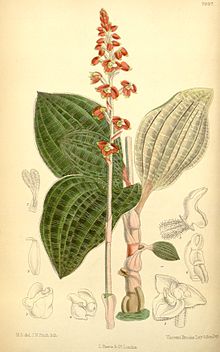
Phragmipedium is a genus of the Orchid family (Orchidaceae) and the only genus comprised in the tribe Phragmipedieae and subtribe Phragmipediinae. The name of the genus is derived from the Greek phragma, which means "division", and pedium, which means "slipper". It is abbreviated 'Phrag' in trade journals.

A tropical garden is a type of garden that features tropical plants and requires heavy rainfall or a decent irrigation or sprinkler system for watering. These gardens typically need fertilizer and heavy mulching.

Hosta is a genus of plants commonly known as hostas, plantain lilies and occasionally by the Japanese name gibōshi. Hostas are widely cultivated as shade-tolerant foliage plants. The genus is currently placed in the family Asparagaceae, subfamily Agavoideae, and is native to northeast Asia. Like many "lilioid monocots", the genus was once classified in the Liliaceae. The genus was named by Austrian botanist Leopold Trattinnick in 1812, in honor of the Austrian botanist Nicholas Thomas Host. In 1817, the generic name Funkia was used by German botanist Kurt Sprengel in honor of Heinrich Christian Funck, a collector of ferns and alpines; this was later used as a common name and can be found in some older literature.
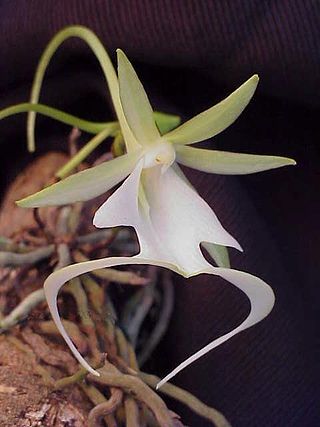
Dendrophylax lindenii, the ghost orchid is a rare perennial epiphyte from the orchid family (Orchidaceae). It is native to Florida, the Bahamas, and Cuba. Other common names include palm polly and white frog orchid.
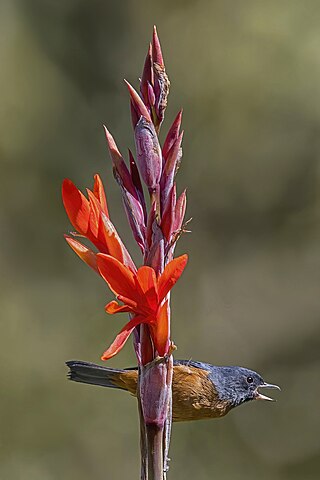
Canna indica, commonly known as Indian shot, African arrowroot, edible canna, purple arrowroot, Sierra Leone arrowroot, is a plant species in the family Cannaceae. It is native to much of South America, Central America, the West Indies, and Mexico. It is also naturalized in the southeastern United States, and much of Europe, sub-Saharan Africa, Southeast Asia, and Oceania.

Paphiopedilum micranthum, described in 1951, is commonly known as the silver slipper orchid or hard-leaved pocket orchid. It blooms during late winter to early summer with one flower per inflorescence. As opposed to its close sibling Paph. malipoense, the flowers of Paph. micranthum have no fragrance.

Dypsis lutescens, also known as golden cane palm, areca palm, yellow palm, butterfly palm, or bamboo palm, is a species of flowering plant in the family Arecaceae, native to Madagascar and naturalized in the Andaman Islands, Thailand, Vietnam, Réunion, El Salvador, Cuba, Puerto Rico, the Canary Islands, southern Florida, Haiti, the Dominican Republic, Jamaica, the Leeward Islands and the Leeward Antilles. Its native names are rehazo and lafahazo.

Spiranthes romanzoffiana, commonly known as hooded lady's tresses or Irish lady's-tresses, is a species of orchid. Collected by Chamisso during the Romanzov expedition it was described by him in 1828 and named for Count Nikolay Rumyantsev who financed the expedition. This orchid is native to North America, Ireland and the British Isles.
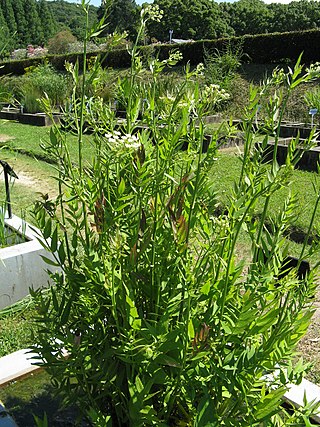
Sium suave, the water parsnip or hemlock waterparsnip, is a perennial wildflower in the family Apiaceae. It is native to many areas of both Asia and North America. The common name water parsnip is due to its similarity to parsnip and its wetland habitat. The alternate common name hemlock waterparsnip is due to its similarity to the highly poisonous spotted water hemlock.
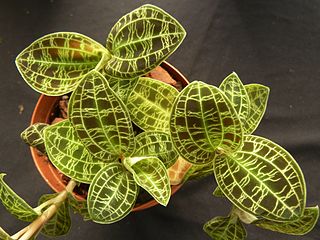
Macodes is one of a few genera of the orchid family known as jewel orchids. These terrestrial orchids grows in the rainforest floor of Southeast Asia with high humidity and low light. They can also be found in New Guinea, Vanuatu, the Solomon Islands and the Ryukyu Islands. The plant is cultivated for the veined leaves, unlike most other orchids that are valued for the flowers.

Narcissus triandrus, also known as the Angel's Tears daffodil, is a species of flowering plant within the family Amaryllidaceae.

Ludisia (Lus.) is a genus of orchids that was thought to contain just one species, Ludisia discolor, commonly referred to as jewel orchid. A second species, Ludisia ravanii, from the Philippines, was described in 2013. Ludisia discolor is native to Southern China, Northeast India, Thailand, Vietnam, the Philippines, Malaysia, Indonesia and Myanmar, and often cultivated.

Maxillaria tenuifolia, the delicate-leafed maxillaria or coconut pie orchid, is a species of orchid ranging from Mexico to Nicaragua and possibly Costa Rica. These plants are easy to grow if kept moist and given good air movement in a high-light windowsill of any orientation but North.

Neottia banksiana is a species of orchid known by the common name northwestern twayblade. It was formerly placed in the genus Listera, but molecular phylogenetic studies have shown that Neottia nidus-avis, the bird's-nest orchid, evolved within the clade formerly containing only Listera species, so all species of Listera have been formally moved to Neottia, the older genus. Some continue to refer to this species by its previous genus; older scientific names include Listera banksiana and Listera caurina.
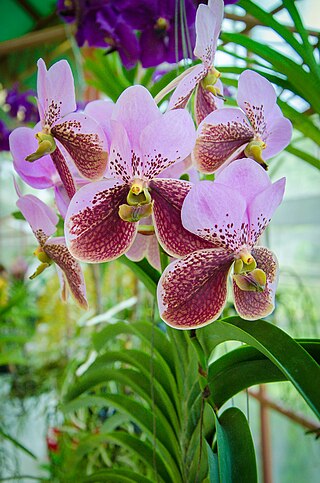
Vanda sanderiana is a species of orchid. It is commonly called Waling-waling in the Philippines and is also called Sander's Vanda, after Henry Frederick Conrad Sander, a noted orchidologist. The orchid is considered to be the "Queen of Philippine flowers" and is worshiped as a diwata by the indigenous Bagobo people.

Psychopsiella is a monotypic genus in the orchid family found only in the state of Rio de Janeiro in Brazil and near Caracas in Venezuela. It grows as an epiphyte in evergreen montane forests at elevations of 800 to 1,500 metres.

Broughtonia sanguinea, also known as blood red broughtonia is a plant in the genus Broughtonia, a member of the family Orchidaceae. It was named in 1813 by its first describer, Robert Brown, for 18th century English botanist Arthur Broughton.
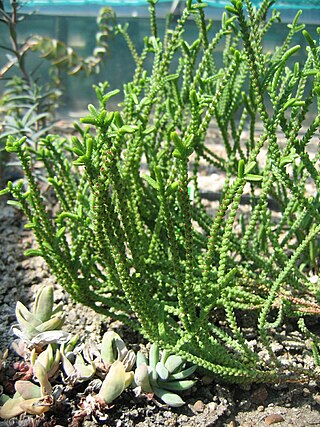
Crassula muscosa, synonyms Crassula lycopodioides and Crassula pseudolycopodioides, is a succulent plant native to South Africa and Namibia, belonging to the family of Crassulaceae and to the genus Crassula. It is a houseplant grown worldwide and commonly known as rattail crassula, watch chain, lizard's tail, zipper plant and princess pines.

Mertensia lanceolata, known as prairie bluebells, narrow-leaved languid lady, lance-leaved bluebells, and lance-leaved lungwort is a species of flowering plant native to western North America. A herbaceous perennial it has blue-green leaves alternately arranged on its smooth flowering stalk. Its flower buds are pink-purple and become more blue as they open. Accepted varieties include:
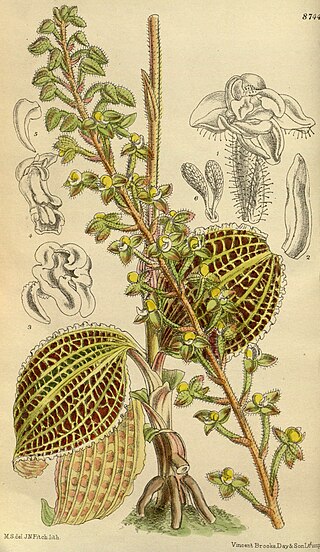
Macodes sanderiana(Kraenzl.) Rolfe is a species of South East Asian jewel orchid mostly recorded from New Guinea but is also found in the Solomon Islands and Vanuatu. This species has a long history of cultivation in Europe since the early 20th century and is prized for its ornamental leaves which are the largest in its genus. The leaves are dark green, the upper surface covered in an intricate network of veins in colors ranging from bright green to copper. In contrast, flowers are small and pallid so are often removed in cultivation. In nature, M. sanderiana grows in rainforests on the forest floor or lithophytically out of rock crevices. This species survives at a broad range of altitudes from close to sea-level, up to the lower boundary of the cloud forest. Exudates from the leaves of this orchid are traditionally used in New Guinea as eye drops for the treatment of myopia. M. sanderiana has not been assessed for the IUCN red list, however, as recently as the 1980’s this species was common in parts of its range within New Guinea.

